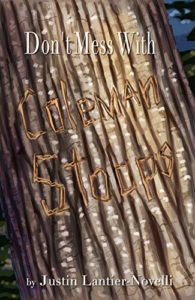“There’s No Such Thing as Pantsers”
Like every other profession and hobby, creative writing has developed its own lingo or jargon writers share with each other; these are phrases that non-writers would neither understand nor care about. Thank NanoWrimo – the month-long writing contest that takes place every November – for coining one of these terms a few years ago to describe writers who never do any planning for their stories. Imagine deciding to compose your very own novel or short story, sitting down at your favorite typewriter or laptop, starting on a blank screen and just going. No thought. No worry. Perhaps not even a developed idea…
That is the essence of being a Pantser: a writer who doesn’t think, he just writes. Maybe the inspiration came from a dream, or a conversation. Maybe there was nothing but a “Once upon a time.” This theory begs to know where the greatest stories of humanity actually come from: the head or the heart? My theory, however, is that Pantsers don’t exist. Even if a writer cracks his knuckles and begins with nothing, once he’s finished his first draft and knows the story and characters a bit, he’s invariably going to proofread, re-tool, and revise his work. Any narrative needs drafting as part of its process. Whether or not you, as a writer, plan at the very beginning (before you start on page one, line one), or you start planning using your first draft as the catalyst, none of us can write without it. Everyone’s a Plotter (the opposite of a Pantser).
Why is planning so important?
There are many reasons. To compose a story that could speak to millions of people isn’t an easy task. It takes a very delicate blend of art and science. The art, comes from the heart, but the science… science is the product of the mind. I would say that 80-90% of my time is spent in the pre-writing phase. I am a plotter with a capital P. I’m also a drafter, as much as I wish I could crank out that flawless first draft (nobody can). Planning can take many forms and has many benefits, some of which will seem obvious to you and some not-so-much. The type of planning you do is also a direct correlation to what you intend your final product to be.
My personal background is in writing for the screen. I went to college for audio/video production and minored in screenwriting. There are some really great ‘how to’ books I can recommend to teach novelists how to craft that perfect character arc or story arc or secondary plot thread – all of which have their roots in motion picture writing. Let’s face it: screenplays were born out of novels, but that doesn’t mean that novelists can’t learn a thing or two from screenwriters.
Which brings me to my first point about planning. Planning gives the writer the ability to stand back and see the story as a god would, as one big picture. Screenwriters are taught to use corkboards and notecards in their planning. Each card is a scene and the board is divided up into the typical (and formulaic) three-act structure: set-up, rising action, resolution. This simple exercise, which I have used for both my screenplays and novels, helps the writer to visualize the arcs. Where will this scene fit best in telling my tale? Is that scene even needed? Once he’s staring at his board with all the scenes displayed, a writer can ask himself: does this scene advance the plot, subplot, or character development at all? If the answer to any of those questions is yes, then the scene is kept. If it’s no, then it can be scrapped (and to use an industry term: to the cutting room floor).
Planning your story arcs is essential in creating the emotional and logical experience that writers want, need, and expect their audience to get. It doesn’t matter if that audience is sitting in a dark room watching the screen, or curled up in their bed turning pages. But what is a story arc? If you know, great. If you don’t, a story arc is comprised of beats, or plot points. Different events throughout the course of a story have to happen to move the plot forward, or drive the character onto becoming the protagonist the writer – and reader – want him to be. And by planning, the writer can see all possible scenes, brainstorming as many as he wants before choosing the perfect one.
The first plot point is also known as the inciting incident (at least in the screenwriting world). No story – in literature or on film – is complete without one.
Would Luke Skywalker been able to destroy the Death Star without R2-D2 and C-3PO taking that escape pod to Tatooine?
Would Romeo and Juliet have ended up dead (to add a bit of high culture to this mix) if Romeo had never crashed the Capulet’s party?
Of course, the inciting incident is only one instance where planning is needed, but each act in the three (or five) act story structure has major plot points. Writers must plan them to do their stories justice and take the reader along on a wondrous journey.
Planning is important in a single, stand-alone novel, however it couldn’t be more essential when writing a series. Series contain multiple story and character arcs, A plot threads, B plot threads, even C plot threads (truly they can be infinite) that span each book individually, but also continue strands across multiple books. Two great examples of writers who plant seeds for future books as part of their pre-writing stage planning are Stephen King and J.K. Rowling – and it’s no accident that they are two of the most successful authors of all time. If you want to see how to plant ideas for future books in a series, just read Harry Potter and The Dark Tower (in fact, King literally has been planting seeds in all his books, even the non-DT works, for decades).
Still not convinced that planning is important? Think about the horcruxes in the Wizarding World… The very first one was revealed in the second book in a seven book series. Rowling didn’t wing her writing. Her seeds were intentionally planted. She knew what horcruxes were before she started typing line one, page one. The rest of us, her loyal readers, didn’t find out until book six! But we didn’t need to know. She did.
The second reason to plan is more about spring cleaning. The more ideas you get out of your system early in your drafting, the more bad ideas you get out of your system. You can easily put together a dozen versions of the same scene, chapter, or character sketch. And all that brainstorming churns the waters of ideas. Sooner or later, the writer will hit the nail on the proverbial head, and get the perfect idea for some aspect or another of his work.
So if you want to clear away bad ideas, take a step back and look at your book(s) from a 3rd person omniscient perspective, then I cannot recommend planning more. Pre-writing is necessary to crafting a well thought out, logical, and emotional story filled with three-dimensional characters that your audience can relate to and keep them furiously flipping pages until the wee hours of the morning.
You can follow Justin Lantier-Novelli on Twitter: @jlnovelli. Find him on Goodreads, Facebook, and Amazon. His debut middle grade fiction novel, Don’t Mess with Coleman Stoops, is available in paperback and for Amazon Kindle.
About the Book: Coleman Stoops just had his twelfth birthday, but he’s not getting popular anytime soon. The kids in his grade call him “Stoopy”. He hates the cruel nickname almost as he hates himself for always managing to accidentally play into it. The clothes he wears, the hobbies he loves, and the way he behaves in school all contribute to his eternal low ranking as the butt of everyone’s jokes. Coleman’s a dork, a dweeb, a nerd. He’s the fool of the school.
So when the most popular kid in his class, B. Bradford Woffington III, approaches him with a proposition and a potential girlfriend, Coleman can’t help ignoring his instincts as they tell him not to trust “Trey”. He accepts the boy’s offer and begins the social and physical grooming that will make him fit for dating – gasp! – a real, live girl. No matter what happens though, Coleman can’t shake the sneaking suspicion that there’s something Trey isn’t being completely forthcoming about. What isn’t the most popular kid in school telling him?
Thank you, Justin! Planning is something all teaches struggle with students understanding, so this post is going to be so helpful!



